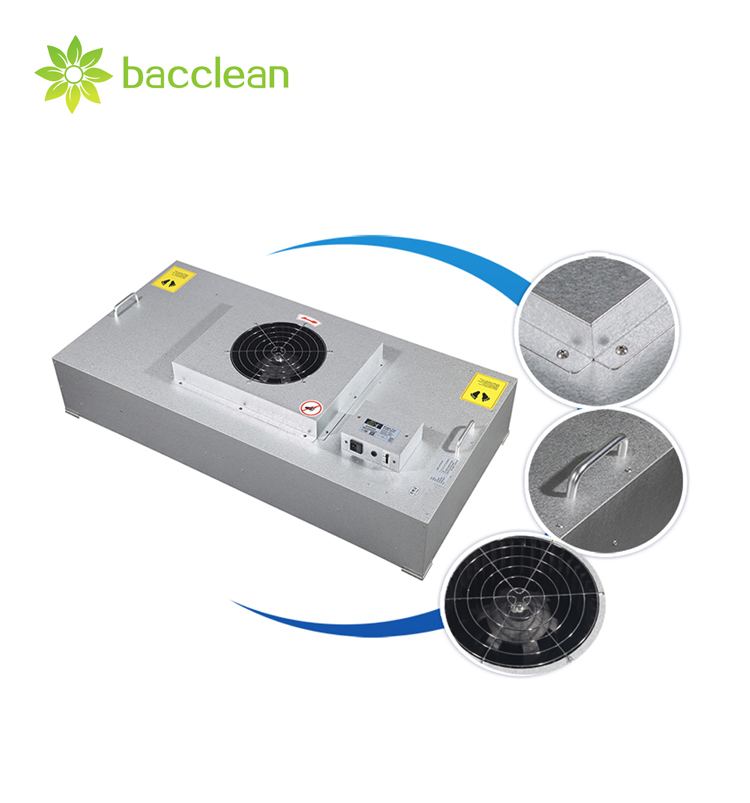Working principle of FFU and laminar flow hood in a clean workshopA dust-free clean workshop is a place specially used to filter and purify dust and microorganisms in the air. It is widely used in the pharmaceutical, electronic, food, and other industries. Among them, high-efficiency air supply outlets, FFU, and laminar flow hoods are important components of clean rooms and play a key role.High-efficiency air supply outlets, FFU, and laminar flow hoods are all equipment used in clean rooms. Their main function is to filter dust particles in the air to meet the cleanliness requirements of the production process. Depending on the air supply method and the location of use, its structure is also different. The high-efficiency air supply outlet consists of an air supply box and a high-efficiency filter, and there is no built-in blower. Its air inlet is connected to the air conditioning box through an air duct. The air sent from the air conditioner enters the air supply box and enters the clean room after being filtered by a high-efficiency filter. High-efficiency air supply outlets are usually installed on the top of the clean room, suitable for turbulent clean rooms, and the cost is relatively high. According to different designs, high-efficiency air supply outlets can be divided into four types: with diffuser, with flat diffuser, insulation, top air intake, and side air intake. When the resistance of the high-efficiency filter in the high-efficiency air outlet is greater than 450Pa, or the airflow velocity on the air outlet surface is reduced to a lower limit, even after replacing the coarse or medium efficiency filter, the airflow velocity still cannot be increased, or the high-efficiency filter has an irreparable leakage, a new high-efficiency filter needs to be replaced. If there is no such situation, the high-efficiency filter is generally replaced every 1-2 years according to the use environment conditions. The full name of FFU in Chinese is "fan filter unit", and its structure consists of a fan, a filter, a control box, and related accessories. Compared with the high-efficiency air outlet, the built-in motor of FFU can drive the fan to realize the air supply function, without the need to arrange the air duct. It is usually installed on the top of the clean room and is suitable for laminar clean rooms. The cost is relatively high. FFU is a high-efficiency filter air outlet with an air supply fan. Together with the keel system, pressurized fan, cooling coil, fresh air system, and lamps, it constitutes the FFU system. By combining the fan and the high-efficiency filter, FFU has its power and is a terminal purification device. It has a three-speed speed regulation function, which can adjust the air volume and wind speed of the air outlet to maintain constant air cleanliness. To facilitate the replacement of the FFU filter and maintain the balance of the fan operation, a matching professional keel frame is generally considered.
The laminar flow hood passes the air through the high-efficiency filter at a certain wind speed to form a uniform laminar layer, so that the clean air enters the working area in the form of vertical unidirectional flow to ensure that the working area reaches the required cleanliness. The laminar flow hood is mainly composed of a box, a fan, a high-efficiency air filter, a damping layer, and lamps. It is one of the equipment used to isolate operators and products. The main purpose is to avoid product contamination. It is located above the clean room. It inhales air through the room and passes vertically through the operating area through the HEPA filter through the fan installed in the top booster cabin, providing ISO 5 level (level 100) unidirectional flow air to the key area. The exhaust gas is discharged from the bottom and returned to the clean room area, so that the particles and microorganisms in the clean room can settle with the airflow, further improving the cleanliness of the indoor environment. The laminar flow hood has a similar working principle to the FFU, and the air supply function is also achieved by driving the impeller with a motor. However, laminar flow hoods are usually used when the existing clean room cannot meet the cleanliness requirements of the production process or the air supply type requirements. It only needs to meet local needs, and the cost of comprehensive transformation is high.
High-efficiency air supply ports, FFUs, and laminar flow hoods are important purification equipment in clean rooms. Through special structural design and the filtering effect of filters, they purify the outside air and send it into the clean room to ensure the cleanliness of the entire clean room. |

 German
German French
French Italian
Italian Portuguese
Portuguese Japanese
Japanese Korrean
Korrean Russian
Russian

.png)




